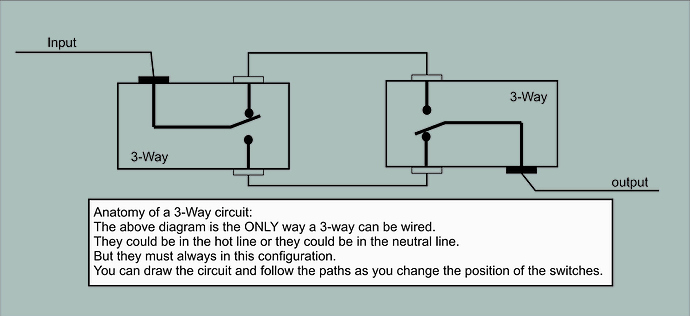Below is a diagram of a 3-Way switch circuit. It shows how simple a 3-Way circuit is to understand once you see what is going on inside the switches.
I purposely did not show wire colors as they can be anything (except the bare wires which are safety ground).
Please post any questions you might have and I’ll be glad to help answer them.
While I said in the other post I’ve never wired a 3-way using a smart/dumb switch combination, after looking at the manual, I see that in this combination the smart switch functions the exact same way as a regular 3-way switch with a neutral added in. So the diagram also holds true when we’re talking a smart switch with a dumb switch.

But this was not the goal of my post. I wanted to simply teach folks how simple a 3-Way switch is wired. With this understanding it will be easier for folks to sort out their existing wiring. I thought it best to leave out any dimmer wiring and focus on the simple 3-Way dumb switches.
Your response would make a good topic for its own post.
One thing it’s worth noting for someone unfamiliar is that while this diagram shows the input and output heading off in opposite directions, the output wire may run back to the same box as the input in a three-conductor Romex (referred to in the documentation as “line and load in same box”, at least when you’re not talking about a switched neutral).
Is it accurate to say that this is typical in newer construction in the US? I only have experience with my own house, built in 2011, but this is how all the 3-ways are wired there.
One thing it’s worth noting for someone unfamiliar is that while this diagram shows the input and output heading off in opposite directions, the output wire may run back to the same box as the input in a three-conductor Romex
Yes this is true. And this diagram could be in the power line or neutral line. My hope was that folks with a 2 x 3-Way switch setup could look at the wires on the switches and know immediately how each wires to its “sister” switch. This can make sorting out the wires in a box much easier.
Is it accurate to say that this is typical in newer construction in the US? I only have experience with my own house, built in 2011, but this is how all the 3-ways are wired there.
If using “dumb” 3-Way switches this is the only way to wire it in any country. This is as much basic electricity as it is house wiring (or should I say electrical wiring to include industrial installations)
I was referring specifically to my observation of load and line in the same box vs different boxes; I understand the configuration of 3-way switches is universal.
AFAIK whether the wire is in the same box or not is a function of the specific wiring condition and not any newer / older requirements or norms.
I do thank you for your observation. It was not my intent to suggest the wiring was per any specific physical implementation. But to your point I will think of how I can add some different physical layouts to help folks see and understand the wiring. Thanks.
John
